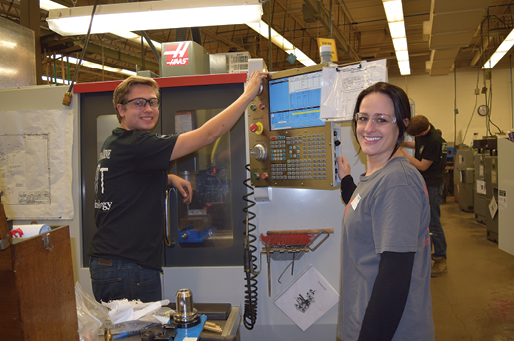High school manufacturing programs teach students to create production parts, preparing them for careers in industry. Those parts are primarily for terrestrial applications. However, unique and exciting opportunities to produce parts for use above the earth are available to partner-schools in a 14-year-old government program called HUNCH (High schools United with NASA to Create Hardware).

NASA program support machinist Amanda Phelps (right) and high school student Brandon Ptak machine stowage locker components on a CNC mill. Image courtesy Bill Rakonczay, Orleans/Niagara BOCES.
“We have flown close to 200 items [manufactured by high school students] into space, with about 100 more in process right now,” said Blake Ratcliff, NASA’s HUNCH program manager, who’s based in Houston. “We have students doing prototype work, build-to-print, software development, communications products—it’s a huge range of products, many for use on the International Space Station or the rockets that fly there.”
A galley table, a specialized tape dispenser, foot restraints for maneuverability and nearly countless individual components are in orbit, all manufactured, and in some cases designed, by teenagers.
Students at the Orleans/Niagara BOCES Orleans Career and Tech Ed Center, Medina, N.Y., have been manufacturing spaceflight hardware for the past 4 years, according to Bill Rakonczay, an instructor at the center.
“We make parts for the International Space Station,” he said. “Every year, it’s different; this year, we’re making parts for stowage lockers—knobs, latches, door panels, bottom plates, fixturing—whatever is needed.”
Students typically machine parts on a Haas CNC mill or lathe, with inspection being done on a coordinate measuring machine.
“There’s a lot of quality control that needs to be done,” Rakonczay noted, “but there’s also a lot of pride involved in making parts for the International Space Station, a lot of motivation to get things right the first time.”
The program, according to Ratcliff, is set up so that the schools provide the students and the facilities, while NASA provides the materials, the drawings and a mentor who works with the students and the faculty and ensures everything is up to NASA standards.
Orleans/Niagara BOCES’ mentor, Amanda Phelps, is a NASA program support machinist who travels from Cleveland every few weeks to work with students, hand out production orders and inspect parts. A build-to-print development cycle can be completed in anywhere from weeks to months, while the prototype and development level projects can take up to a year.
However, HUNCH is looking to expand its reach.
“We are reaching out to partners in industry to work with our schools,” Ratcliff said, “to outfit them with the latest equipment and the latest methods. The goal is that when these kids graduate, they will not only have built actual spaceflight hardware, but they will be ready for whatever the next step may be, whether it’s into the workforce or further in academia.”
Related Glossary Terms
- computer numerical control ( CNC)
computer numerical control ( CNC)
Microprocessor-based controller dedicated to a machine tool that permits the creation or modification of parts. Programmed numerical control activates the machine’s servos and spindle drives and controls the various machining operations. See DNC, direct numerical control; NC, numerical control.
- lathe
lathe
Turning machine capable of sawing, milling, grinding, gear-cutting, drilling, reaming, boring, threading, facing, chamfering, grooving, knurling, spinning, parting, necking, taper-cutting, and cam- and eccentric-cutting, as well as step- and straight-turning. Comes in a variety of forms, ranging from manual to semiautomatic to fully automatic, with major types being engine lathes, turning and contouring lathes, turret lathes and numerical-control lathes. The engine lathe consists of a headstock and spindle, tailstock, bed, carriage (complete with apron) and cross slides. Features include gear- (speed) and feed-selector levers, toolpost, compound rest, lead screw and reversing lead screw, threading dial and rapid-traverse lever. Special lathe types include through-the-spindle, camshaft and crankshaft, brake drum and rotor, spinning and gun-barrel machines. Toolroom and bench lathes are used for precision work; the former for tool-and-die work and similar tasks, the latter for small workpieces (instruments, watches), normally without a power feed. Models are typically designated according to their “swing,” or the largest-diameter workpiece that can be rotated; bed length, or the distance between centers; and horsepower generated. See turning machine.
- milling machine ( mill)
milling machine ( mill)
Runs endmills and arbor-mounted milling cutters. Features include a head with a spindle that drives the cutters; a column, knee and table that provide motion in the three Cartesian axes; and a base that supports the components and houses the cutting-fluid pump and reservoir. The work is mounted on the table and fed into the rotating cutter or endmill to accomplish the milling steps; vertical milling machines also feed endmills into the work by means of a spindle-mounted quill. Models range from small manual machines to big bed-type and duplex mills. All take one of three basic forms: vertical, horizontal or convertible horizontal/vertical. Vertical machines may be knee-type (the table is mounted on a knee that can be elevated) or bed-type (the table is securely supported and only moves horizontally). In general, horizontal machines are bigger and more powerful, while vertical machines are lighter but more versatile and easier to set up and operate.
- quality assurance ( quality control)
quality assurance ( quality control)
Terms denoting a formal program for monitoring product quality. The denotations are the same, but QC typically connotes a more traditional postmachining inspection system, while QA implies a more comprehensive approach, with emphasis on “total quality,” broad quality principles, statistical process control and other statistical methods.







